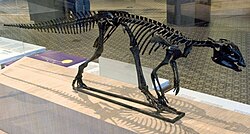Hypsilophodon
|
Hypsilophodon Temporal range: Early Cretaceous, 130–125 Ma |
|
|---|---|
 |
|
| Replica at Brussels Science Institute | |
| Scientific classification | |
| Kingdom: | Animalia |
| Phylum: | Chordata |
| Class: | Reptilia |
| Clade: | Dinosauria |
| Order: | †Ornithischia |
| Suborder: | †Ornithopoda |
| Family: | †Hypsilophodontidae |
| Genus: |
†Hypsilophodon Huxley, 1869 |
| Species: | †H. foxii |
| Binomial name | |
|
Hypsilophodon foxii Huxley, 1869 |
|
Hypsilophodon (/ˌhɪpsᵻˈlɒfoʊdɒn/; meaning "Hypsilophus-tooth") is an ornithopod dinosaur genus from the Early Cretaceous period of England.
The first remains of Hypsilophodon were found in 1849; the type species, Hypsilophodon foxii, was named in 1869. Abundant fossil discoveries were made on the Isle of Wight, giving a good impression of the build of the species. It was a small bipedal animal with an herbivorous or possibly omnivorous diet. Hypsilophodon reached up to 1.8 metres (5.9 ft) in length, weighed about 20 kg (45 lbs), and was an agile runner. It had a pointed head equipped with a sharp beak used to bite off plant material, much like modern day parrots.
Older studies have given rise to number of misconceptions about Hypsilophodon: that it would climb trees, were armoured, reached a length of 2.3 metres (7.5 ft) and were also found outside of Wight. During the past decades new research has gradually shown this to be incorrect.
The first remains of Hypsilophodon were recovered in the early days of paleontology in 1849, when workers on the Isle of Wight dug up the so-called Mantell-Bowerbank block. One piece of it was sold to Gideon Mantell, the other to naturalist James Scott Bowerbank. However, at the time, the bones were thought to belong to a young Iguanodon: first Mantell in 1849, and then Richard Owen in 1855 describing the block as such.
...
Wikipedia
